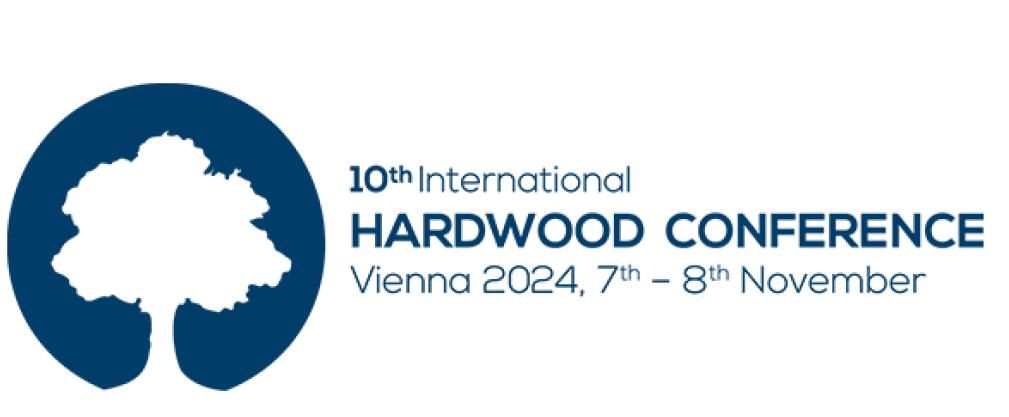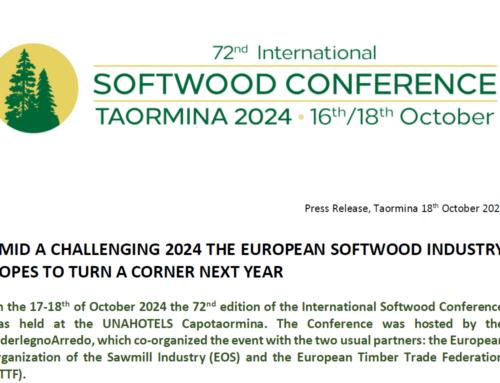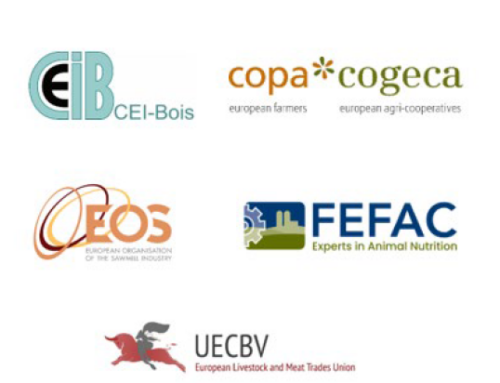
AMID LONG-TERM CHALLENGES AND OPPORTUNITIES, THE EUROPEAN HARDWOOD INDUSTRY LOOKS TO THE FUTURE AFTER A TOUGH YEAR
On November 7-8th the 10th edition of the International Hardwood Conference was held at the Hilton Vienna Park in the Austrian capital. The Conference was hosted by the Fachverband der Holzindustrie Österreichs, which co-organized the event with the two usual partners: the European Organization of the Sawmill Industry (EOS) and the European Timber Trade Federation (ETTF).
Vienna (Austria), 8th November – The event drew many participants as around 150 people – coming from 26 countries all over the world – attended the conference.
On the 7th participants had the opportunity to attend an interesting study tour – the group visited three companies, including the innovative parquet company Weitzer Parkett, Mühlbauer Holz, a leading timber merchant in Austria, and TEAM 7, which produces top-notch, custom-made solid wood furniture.
On the 8th the conference was opened by an economic overview provided by Christoph Schneider of the Economica Institute. Mr Schneider showed that increasing global tensions are having a negative effect on stability. Businesses will operate in an increasingly challenging environment but there will also be opportunities such as mainstreaming of artificial intelligence. Silvio Schüler of the Austrian Research Centre for Forests delivered an insightful presentation on European hardwood forests. The share of hardwood forests is rising across Europe and with climate change trees are growing faster. Forests’ health is key for a stable provision of raw materials to the hardwood industry. However, climate change and forests pests are threatening forests’ vitality. Adapting forest management to these changed conditions is very important as well as increasing material uses of hardwood.
Presentations about the market situation around the world were delivered in the second session of the Conference. In their introducing remarks, Mrs Maria Kiefer-Polz, EOS Vice-President for Hardwood, and Mr Ad Wesselink, ETTF President, argued that in Europe the last couple of years were quite challenging for the hardwood businesses. The big question mark for operators in the sector is whether the market has bottomed out and 2025 can really be the year of recovery. The hardwood businesses are also adjusting to a new cost structure amid higher costs for energy, personnel, equipment etc.
Michael Snow of the American Hardwood Export Council showed that 2024 is a quite difficult year on the other side of the Atlantic as well. Production in the United States has been on a long-term declining trend due to weak home demand for basically all hardwood applications. Exports to overseas countries are sluggish but, overall, slightly better than US demand. However, subdued Chinese demand is taking a toll. In his presentation about the Chinese market, Mr James Xu of Shanghai AM Forest Products stressed the importance of using new sales channels such as local social media to maintain market share in the challenging Chinese. Innovative sales methods are really gaining momentum in China.
Jean-Christophe Claudon of the International Timber Trade Organization delivered a presentation about tropical wood. Tropical sawnwood production as a share of overall global sawnwood production has been relatively stable over the last 30 years at around 13/15%.
A very relevant market for the hardwood industry – the parquet market – is also going through a difficult period, as Ms Isabelle Brose showed in her presentation on trends in the European parquet industry. The sector is focusing on incremental innovation such as, among other things, water-resistant, acoustic and smart wood flooring.
In the Q&A session, better promotion of products is seeing as crucial for the future of the sector by presenters intervening in the morning, particularly as younger consumers are increasingly sensitive to environment-friendly products such as sustainably produced hardwood.
In the afternoon, Mr Harald Mauser of the European Forest Institute, gave an overarching presentation on the impact of EU legislation on the forestry sector. Unfortunately, an impact assessment calculating EU legislation costs for the sector is missing, also considering that policies affecting the sector are on the rise. On a brighter, the reduction of administrative burdens is one of the targets of the new European Commission, but it remains to be seen how this will be applied in practice. The enhanced stress on a circular bioeconomy provides opportunities for the sector but the policy framework needs to be coherent. Dialogue with decision-makers and the wider public will be vital for the woodworking industry, including for the hardwood industry.
The audience was then treated to two relevant panel discussions.
A crucial topic of the conference, the EU Deforestation-free Regulation (EUDR), has been addressed in the first panel discussion and preceded by a comprehensive introductory presentation delivered by Franz-Xaver Kraft of GD Holz. The announced “entry into application” delay expected to be approved soon by the EU Institutions has been unquestionably welcomed by the international timber industry, which is working hard to implement the challenging requirements imposed by the EUDR. Certification schemes such as PEFC and FSC, which were also on stage, offer valuable support for companies aiming to comply with the EUDR by providing traceability frameworks, risk assessment tools, deforestation-free standards, and documentation that align closely with the regulation’s requirements. While companies may need to implement supplementary due diligence measures, certification schemes provide an effective foundation for ensuring compliance with the EUDR and reducing the administrative, legal, and logistical challenges associated with the new regulation.
The second discussion was very inspiring and focused on innovation in the hardwood sector. The speakers’ interventions focused on innovation in hardwood furniture and construction, both on the possible uses for hardwood in construction and on the potential for wood-based hybrid constructions. The last session has been opened by an overarching presentation on possible new material concepts for the hardwood sector.
For more information on the 2024 edition of the International Hardwood Conference, please visit the website https://ihc2024.at/. Also, the 2026 edition of the conference, hosted by an ETTF member federation, will be announced in the course of the coming two weeks.
Related Posts
Contact
EUROPEAN ORGANISATION
OF THE SAWMILL INDUSTRY AISBL
Rue Montoyer 24/box 20
BE-1000 Brussels
Tel.: +32 2 287 08 68
Email: info@eos-oes.eu




